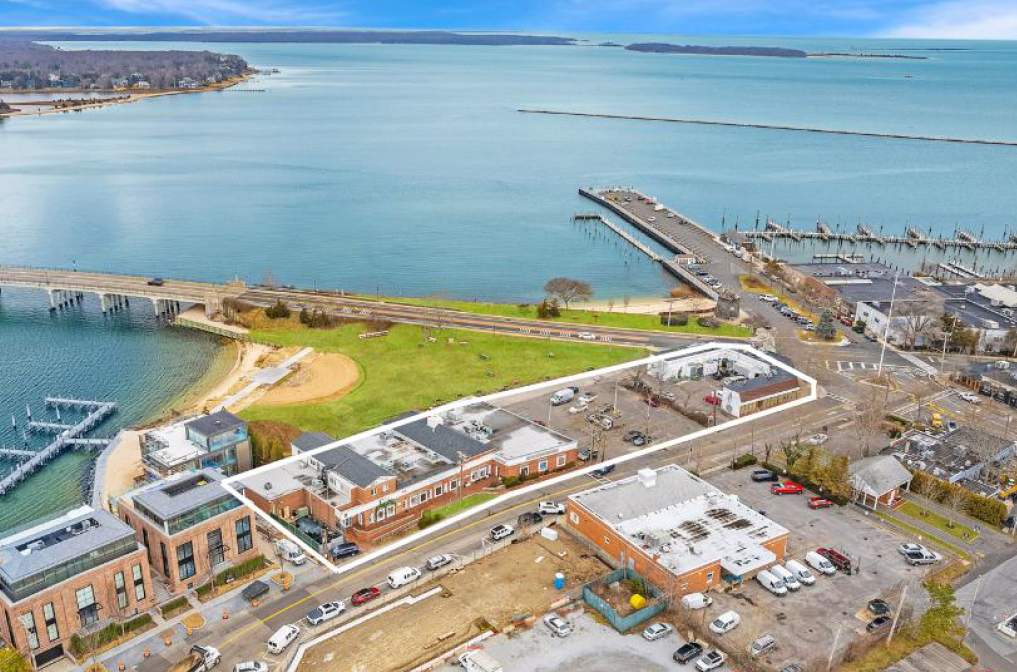Einstein’s Letter: What He Wrote the President from Southold
Albert Einstein summered on eastern Long Island. It was in 1939 and he was then an older man, a professor teaching at Princeton, many years removed from the time in his youth when he stunned the world with his creation of the theory of relativity.
He lived that summer in a small house with a screened-in front porch on Nassau Point, a four-mile-long peninsula that juts down from the North Fork into Peconic Bay directly across from Southampton.
Einstein spent that summer working during the day trying to prove his Unified Field Theory, an idea he had about relating the general theory of relativity and electromagnetism. (He never could prove it.) In the evenings, he met with friends—among them David Rothman (see the photo above) of Rothman’s Department Store in Southold—played his violin and got to join an amateur string quartet playing classical music, or just read or listened to events on the radio.
He also, during the daylight hours, enjoyed one of his favorite sports, which was sailing. There are well-known photographs of him sailing his little catboat with its one sail in Peconic Bay, wearing a white polo shirt, shorts, sandals without socks and a hat made of folded-up newspaper to protect him from the sun. He called his little boat “Tinif.” This translates from Yiddish as “junk.”
This was a very peaceful time for him. He enjoyed his days that summer with members of his family, his sister Maja, his step-daughter Margot and his son Hans. There was also a little Airedale Terrier running around. Also, of course, there was his longtime secretary, Miss Helen Dukas.
It was not a peaceful time for the world, however. That summer, a vicious and charismatic maniac named Adolph Hitler was massing his German army on the Polish border and was about to hurl more than a million men, tanks, artillery and planes into that country to fight an army whose elite force was on horseback. Earlier that year, he had been warned that if he did invade Poland, England and France would declare war against him. It would be the match that lit World War II, in which more than 20 million people would die. Hitler, of course, went ahead anyway. Just before Labor Day, on September 1, 1939, he launched the attack. Poland fell in six weeks.
People familiar with Einstein’s summer on Nassau Point know that in mid-summer, six weeks before the war began, an event took place at his house that was to have a profound effect on not only the war but on everything since.
In mid-July, two men in a car drove out from the city and, after losing their way and getting directions from a young boy, arrived at the Einstein home on Nassau Point. They were Leo Szilard and Eugene Wigner, scientists Einstein knew personally both in America and in Europe, where they’d lived before. Wigner was now a fellow professor at Princeton. Szilard was doing important research in nuclear reactions at Columbia University with Enrico Fermi. Einstein was on the porch when they arrived.
The reason they needed to see Einstein, they told him when they saw him, was that experiments were leading them to believe it would be possible to create an atomic bomb. They also believed that the Germans were working on such experiments. And they thought it urgent that this information be brought to the attention of
President Roosevelt.
It had been only six years since Einstein, already famous around the world, had fled Berlin for America after Nazi Brown Shirts had invaded his home one night looking for weapons (they found only a bread knife). He better look out.
Einstein had been greeted in New York City as a celebrity when he came to America for the first time. He was given the keys to the city and a ticker tape parade up Broadway, the only such parade ever given to a scientist before or since.
The two fellow scientists visiting Einstein at his North Fork home told him that they could write a letter, but the only scientist well enough known to get the President’s attention with a letter would be Einstein. They showed him, in manuscript form, some of the experiments being done, and, after looking that over, he told them he would sign a letter if they all agreed on what it should say. They sat around a table on the porch and discussed what should be written. Two weeks later, Szilard drove out again with another scientist, Edward Teller, and they worked on the letter further. In the end, they produced a number of drafts, and a week later, a final letter was presented, dated August 2, 1939, which Einstein signed. And if course, it did alter history.
As an historian, I have always been curious to see this letter. And the other day, I came upon this actual letter in an exhibit at the New York Historical Society on Central Park West in Manhattan. It’s in a glass case with a spotlight on it, in an exhibit of artifacts about New York in World War II, and it will be displayed there through May 27, 2013.
There are some interesting things about this letter. For one thing, Einstein, in describing what a bomb such as this could do, wrote “a single bomb of this type, carried by boat and exploded in a port, might very well destroy the whole port together with some of the surrounding territory. However, they might very well prove to be too heavy for transportation by air.” We know what happened.
Another interesting thing is how Einstein brings the Germans into the conversation. He writes most of the letter about how the work needs major funding (that’s what the scientists hoped the letter will get the President to provide). And then, only at the very end, does he mention Germany. Keep in mind that Roosevelt was already frantically arming America for war by this time, having seen the danger headed our way, but was under intense pressure from “America Firsters,” a group of Americans who wanted the United States to stay out of the conflict at all costs. Let Europe work out their problems, they felt. Then America could deal with Hitler.
Einstein’s comments about Germany in this letter come from out of nowhere—it’s sort of “by the way:”
“I understand that Germany has actually stopped the sale of uranium from the Czechoslovakian mines she has taken over,” he writes. “That she has taken such early action might best be understood on the ground that the son of the German Secretary of State Von Weisacker is attached to the Kaiser Wilhelm Institut in Berlin where some of the important work in Uranium is now being repeated.”
The date of this letter, as I have said, was August 2, 1939. After the scientists left Einstein that last time and were driving home, they tried to think of how they might get this important letter into the hands of the President as quickly as possible. The amount of mail he was receiving, of course, had to be overwhelming. How could this stand out?
Read the full letter by clicking on the image below.
They had thought to try to get Charles Lindbergh to deliver it, but given his German leanings, they decided instead to hand the letter to an economist named Alexander Sachs, who sometimes worked directly with the President. Sachs could, on his next visit with the President, hand it to him. But that did not happen very soon.
Sachs, given everything that was going on soon thereafter—the beginning of the war in Europe, the sinking of American merchant ships at sea, the cries from Europe and the responses from America Firsters—was unable to hand the letter to Roosevelt until October 11. When he did, Roosevelt read it with alarm. He would immediately create a committee to determine the best and fastest thing to do to get Americans on this. Shortly, work would begin at the secret lab at Oak Ridge, Tennessee.
In addition to that order, eight days later, Roosevelt responded to Einstein by letter informing him of what he had done.
As you will note from reading the letter that accompanies this article (and which I photographed on my iPhone just before a guard said no photography please—and I said okay), whoever typed it up gave Einstein’s return address at the top as “Albert Einstein, Old Grove Road, Peconic, Long Island.”
Roosevelt’s reply, which I also have read, and which you can see at DansHamptons.com, is dated October 19 and had been sent out to Albert Einstein at that very address.
I was intrigued by the address. Nassau Point is not mentioned. Nassau Point today is a wealthy enclave of homes similar in some ways to the estate section in Southampton or Georgica in East Hampton. But as I learned when I drove over there the other day just for fun to try to find this house, the road where it was is West Cove Road, a street whose name had been changed from Old Cove Road. For whatever reason, it was typed up as Old Grove Road. It was sent out with that street name, and the President replied to that street name.
One wonders what the postmaster at the Peconic Post Office did when he received the letter to Einstein in October. Summer was over and Einstein had moved back to Princeton. And the street name was wrong. WRONG ADDRESS. NO PERSON BY THIS NAME AT THIS ADDRESS. RETURN TO SENDER? Ah, well, Miss Dukas, an efficient woman, had probably filled out a change of address form when they left. So all was well.
In any case, the house is still there, but with many additions to it and so practically unrecognizable. You can see the bay from the house. Einstein would have been able to see where his boat would tie up there on Horseshoe Cove. But he would have had to take a long walk to get to it, unless the owner of the house between his and the water agreed to allow him to walk across the lawn—which that homeowner, when asked, said he would not.
* * *
Here is another interesting piece of history I have come across. I’m reading Winston Churchill’s The Gathering Storm, his memoir about the months before WWII. He’s a member of Parliament in August of 1939, but not part of the administration. In his book, he reprints a private letter he wrote to Prime Minister Neville Chamberlain about the work secretly done in Germany to try to split the atom. He writes that he doesn’t think this is anything to worry about, at least at the present time. The date of this letter is August 5, 1939. This is three days after Einstein’s letter to Roosevelt, which Roosevelt did not see until October 11.
For more about Albert Einstein’s summer in Nassau Point, read the new book My Grandfather and Albert Einstein, edited by Ron Rothman, the current owner of Rothman’s Department Store and the grandson of David Rothman, who came to know Einstein well in Southold in 1939.




